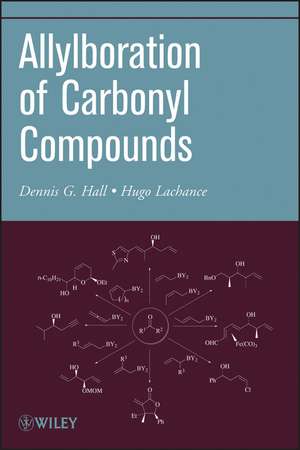Organic Reactions V73 Carbonyl Allylboration: Organic Reactions
Autor DG Hallen Limba Engleză Paperback – 28 iun 2012
Din seria Organic Reactions
- 23%
 Preț: 1963.76 lei
Preț: 1963.76 lei - 14%
 Preț: 1939.56 lei
Preț: 1939.56 lei - 9%
 Preț: 757.75 lei
Preț: 757.75 lei - 9%
 Preț: 904.26 lei
Preț: 904.26 lei - 9%
 Preț: 1631.50 lei
Preț: 1631.50 lei - 9%
 Preț: 1419.10 lei
Preț: 1419.10 lei - 9%
 Preț: 2041.37 lei
Preț: 2041.37 lei - 9%
 Preț: 2480.76 lei
Preț: 2480.76 lei - 9%
 Preț: 2343.64 lei
Preț: 2343.64 lei - 9%
 Preț: 2728.44 lei
Preț: 2728.44 lei - 9%
 Preț: 1120.81 lei
Preț: 1120.81 lei - 9%
 Preț: 1417.72 lei
Preț: 1417.72 lei - 9%
 Preț: 1186.64 lei
Preț: 1186.64 lei - 33%
 Preț: 1099.96 lei
Preț: 1099.96 lei - 32%
 Preț: 1102.12 lei
Preț: 1102.12 lei - 33%
 Preț: 1097.67 lei
Preț: 1097.67 lei - 32%
 Preț: 1103.24 lei
Preț: 1103.24 lei - 33%
 Preț: 1091.86 lei
Preț: 1091.86 lei - 33%
 Preț: 1154.66 lei
Preț: 1154.66 lei - 32%
 Preț: 1105.73 lei
Preț: 1105.73 lei - 32%
 Preț: 1108.79 lei
Preț: 1108.79 lei - 33%
 Preț: 1162.57 lei
Preț: 1162.57 lei - 32%
 Preț: 1119.09 lei
Preț: 1119.09 lei - 32%
 Preț: 1109.51 lei
Preț: 1109.51 lei - 33%
 Preț: 1160.06 lei
Preț: 1160.06 lei - 33%
 Preț: 1099.77 lei
Preț: 1099.77 lei - 33%
 Preț: 1160.79 lei
Preț: 1160.79 lei - 32%
 Preț: 1103.38 lei
Preț: 1103.38 lei - 32%
 Preț: 1105.38 lei
Preț: 1105.38 lei - 32%
 Preț: 956.89 lei
Preț: 956.89 lei - 32%
 Preț: 1104.66 lei
Preț: 1104.66 lei - 32%
 Preț: 1103.75 lei
Preț: 1103.75 lei - 33%
 Preț: 1100.84 lei
Preț: 1100.84 lei - 32%
 Preț: 919.60 lei
Preț: 919.60 lei - 32%
 Preț: 1104.11 lei
Preț: 1104.11 lei - 32%
 Preț: 931.38 lei
Preț: 931.38 lei - 32%
 Preț: 1116.91 lei
Preț: 1116.91 lei - 33%
 Preț: 1160.22 lei
Preț: 1160.22 lei - 32%
 Preț: 1120.15 lei
Preț: 1120.15 lei - 33%
 Preț: 1097.08 lei
Preț: 1097.08 lei - 33%
 Preț: 1095.30 lei
Preț: 1095.30 lei - 33%
 Preț: 1157.01 lei
Preț: 1157.01 lei - 33%
 Preț: 1093.30 lei
Preț: 1093.30 lei - 32%
 Preț: 1105.19 lei
Preț: 1105.19 lei - 33%
 Preț: 1156.45 lei
Preț: 1156.45 lei - 31%
 Preț: 881.50 lei
Preț: 881.50 lei - 33%
 Preț: 1157.01 lei
Preț: 1157.01 lei - 32%
 Preț: 925.38 lei
Preț: 925.38 lei - 32%
 Preț: 1103.24 lei
Preț: 1103.24 lei
Preț: 508.22 lei
Preț vechi: 552.42 lei
-8% Nou
Puncte Express: 762
Preț estimativ în valută:
97.26€ • 101.17$ • 80.29£
97.26€ • 101.17$ • 80.29£
Carte tipărită la comandă
Livrare economică 14-28 aprilie
Preluare comenzi: 021 569.72.76
Specificații
ISBN-13: 9781118344453
ISBN-10: 1118344456
Pagini: 596
Dimensiuni: 157 x 228 x 31 mm
Greutate: 0.76 kg
Ediția:Volume 87
Editura: Wiley
Seria Organic Reactions
Locul publicării:Hoboken, United States
ISBN-10: 1118344456
Pagini: 596
Dimensiuni: 157 x 228 x 31 mm
Greutate: 0.76 kg
Ediția:Volume 87
Editura: Wiley
Seria Organic Reactions
Locul publicării:Hoboken, United States
Public țintă
Information for Sales Representatives:Appropriate for chemistry libraries (upper–level and graduate level chemistry students and professors) as well as organic chemists and libraries in industries such as pharmaceuticals, fine chemicals, agrochemicals, and biotech. (keywords: organic, synthesis, development – including drug development and other chemical product development). Information for Marketing/LN:
Students and professionals in organic chemistry and medicinal chemistry in academia, government, and industries including pharmaceuticals, fine chemicals, agrochemicals, and biotech.
Cuprins
Notă biografică
DENNIS G. HALL received his PhD from Université de Sherbrooke in 1995 and is now University Professor of Chemistry at the University of Alberta, Canada. The unifying theme of his research program is the development of new synthetic and biological applications of organoboronic acid derivatives, with topics including stereocontrolled reaction methodology, catalysis, multicomponent reactions, and chemical biology. HUGO LACHANCE received his PhD from the University of Alberta in 2006 under the supervision of Prof. Dennis Hall. He is now Scientific Coordinator at Pharmaqam and Adjunct Professor at Université du Québec à Montréal. His research interests include asymmetric methodology, bioactive natural products, biological target identification, and protein labeling.
Descriere
Allylic boron compounds have gained a prominent position as a truly practical class of synthetic reagents in the past twenty-five years. Their main application as a method for the stereoselective synthesis of homoallylic alcohols by allyl-transfer to carbonyl compounds is essentially unmatched.














